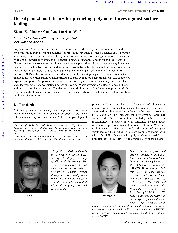摘要
Polymer-based "non-stick'' surfaces have been proposed as the next generation of effective and environmentally-friendly coating materials for protecting implanted biomedical devices and for marine antifouling. However, identification of polymeric systems for universal fouling control is often impeded by the poor knowledge of interactions between biological substances and polymeric substrates in diverse aqueous environments. In this article, we review predictions of the polymer density functional theory (DFT) on the structural and surface properties of polymer brushes and polymer nanocomposites that are potentially useful for antifouling applications. In comparison to alternative theoretical methods, DFT exhibits versatile features that are ideal for investigating various polymer-mediated interactions, self-organization of nanoparticles, and surface-induced phase transitions. It is capable of explicit description of important microscopic details of polymeric systems including the molecular excluded-volume effects, associating interactions, van der Waals attraction, Coulomb forces, and inter- and intra-molecular correlations. The theoretical descriptions of surface forces may provide helpful guidelines in the design and development of polymeric materials for preventing non-specific adsorption of biological substances.
- 出版日期2010
- 单位北京化工大学
